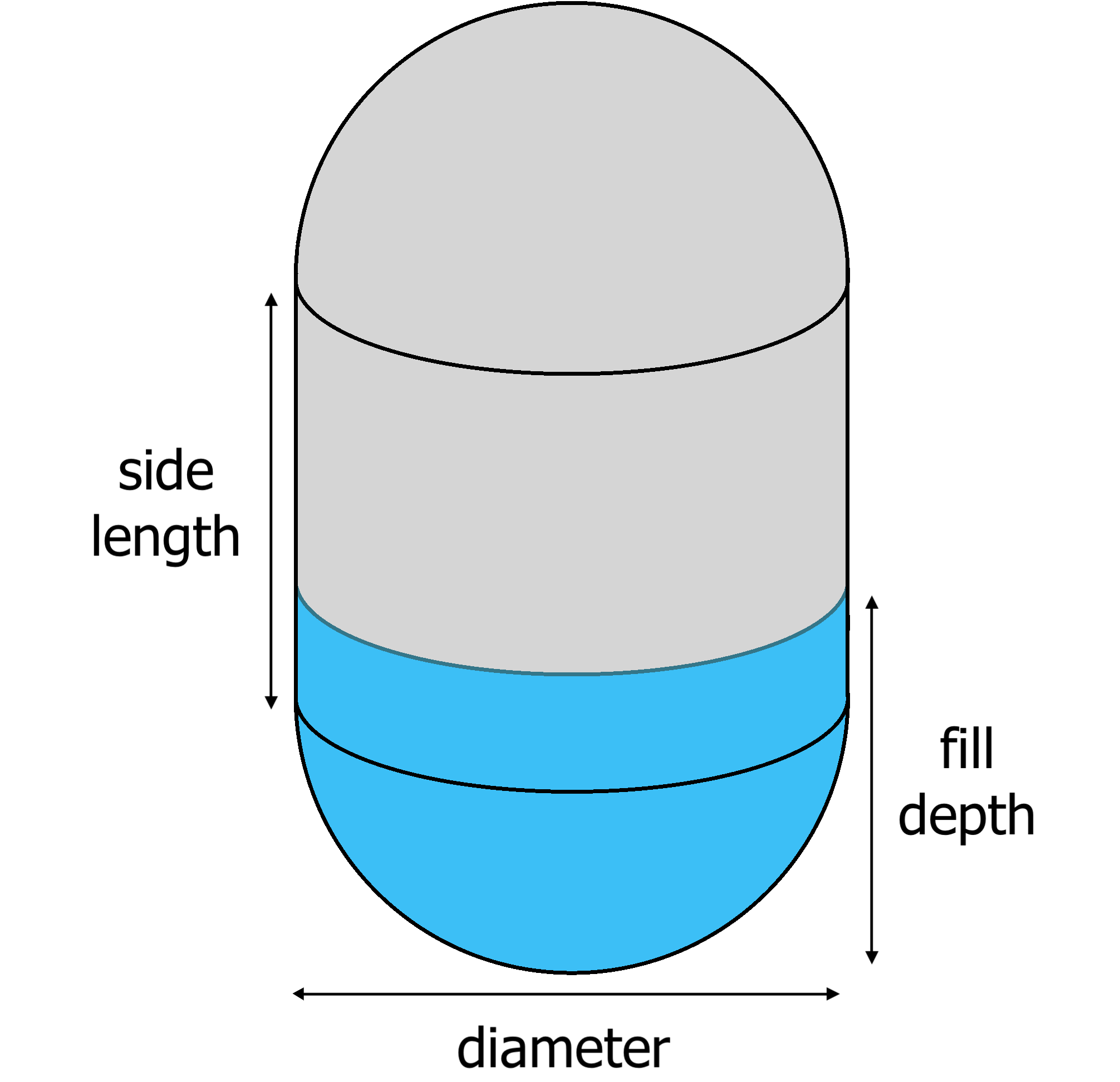Tank Volume Calculator
Select the style of tank and its dimensions to calculate the capacity in gallons and liters. Optionally, enter the filled depth to calculate the volume of liquid in a tank.
Calculate Horizontal Cylinder Tank Volume
Calculate Vertical Cylinder Tank Volume
Calculate Horizontal Oval Tank Volume
Calculate Vertical Oval Tank Volume
Calculate Horizontal Capsule Tank Volume
Calculate Vertical Capsule Tank Volume
Calculate Rectangular Tank Volume
Calculate Sphere Tank Volume
Tank Volume Estimate:
| gallons | |
| liters |
Filled Volume
| gallons | |
| liters |
On this page:
How to Calculate Tank Volume
You can find the volume, or capacity, of a tank in a few easy steps. Of course, the calculator above is the easiest way to calculate tank volume, but follow along to learn how to calculate it yourself.
Step One: Measure the Dimensions of the Tank
The first step is to measure the key dimensions of the tank. For spherical tanks, find the diameter or radius. For cylindrical tanks, find the diameter or radius and length or height. For rectangular or cubic tanks, find the length, width, and height.
Step Two: Use the Applicable Tank Volume Formula
In order to calculate a tank’s capacity, you’ll need a formula for its volume. The volume formula varies for each shape of tank. See the formulas below and select the appropriate one for your tank.
Cylinder Tank Formula
tank volume = π × r2 × l
r = radius (diameter ÷ 2)
l = length (or height for a vertical tank)

Oval Tank Formula
This tank shape can be thought of as a cylindrical tank cut in half lengthwise with a rectangular tank inserted between the two halves. Therefore, the total volume is equivalent to the volume of the cylindrical part plus the volume of the rectangular part.
area = ((h – w) × w) + (π × r2)
tank volume = area × l
r = radius (width ÷ 2)
w = width
l = length
h = height

Capsule Tank Formula
This tank shape can be thought of as a sphere cut in half with a cylindrical tank inserted between the two halves. Therefore, the volume is equivalent to the volume of the cylindrical part plus the volume of the spherical part.
cylinder volume = π × r2 × l
sphere volume = 4/3 π × r3
tank volume = cylinder volume + sphere volume
r = radius (diameter ÷ 2)
l = length (or height for a vertical tank)

Rectangular Tank Formula
tank volume = l × w × h
l = length
w = width
h = height

Not finding a formula for the shape of your tank? Find even more volume formulas.
Step Three: Solve the Formula for Volume
When you have the tank dimensions and the appropriate formula to solve for volume, simply enter the dimensions into the formula and solve.
For example, let’s find the volume of a cylindrical tank that is 36″ in diameter and 72″ long.
radius = 36″ ÷ 2
radius = 18″
tank volume = π × 182 × 72
tank volume = 73,287 cu in
Thus, the capacity of this tank is 73,287 cubic inches.
Step Four: Convert Volume Units
The resulting tank volume will have the three-dimensional equivalent of the dimension’s units. For instance, if the initial tank measurements were in inches, then the volume measurement would be in cubic inches.
Depending on what you need to know the volume for, you’ll often need to convert it to different units, such as gallons or liters.
Thus, the final step is to convert the volume from one unit volumetric measurement to the desired unit. Try our volume converter to convert a volume to gallons, liters, or any other unit.
Curious how much a tank full of water weighs? Calculate it using our water weight calculator.
Frequently Asked Questions
How do you read tank levels?
How to read tank levels depends on the type of tank. For example, a rectangular tank of water often has notches on its side, and you can read the volume depending on which notch the water line is at.
For a pressurized propane tank, as another example, the tank often comes with a gauge that reads the percentage of remaining fuel. To calculate the tank level, just multiply that reading (as a decimal) by the total volume of the tank.
For example, if a 40-gallon tank has a reading of 60%, there are 24 gallons of propane remaining:
40 gallons × 0.6 = 24 gallons
How do you find the volume in gallons given liters?
One gallon equals 3.78541 liters. Therefore, when given a volume in liters, divide by 3.78541 to convert to gallons. For example, 20 liters equals 5.283 gallons:
20 liters ÷ 3.78541 liters per gallon = 5.283 gallons
How much volume does a propane tank hold?
There are several common sizes of propane tanks with various capacities:
- A 20 lb propane tank holds 4.6 gallons of propane.
- A 30 lb propane tank holds 7 gallons of propane.
- A 40 lb propane tank holds 9.4 gallons of propane.
- A 100 lb propane tank holds 23.6 gallons of propane.






